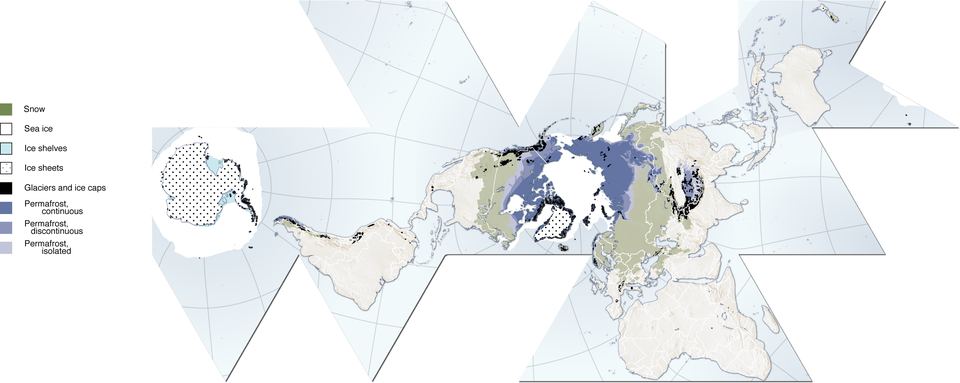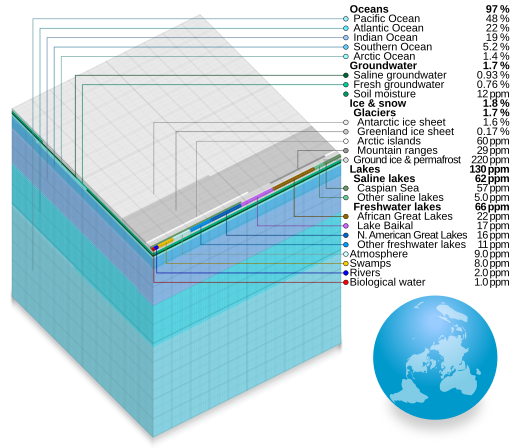AQA Specification focus:
‘Global distribution and size of major stores of water – lithosphere, hydrosphere, cryosphere and atmosphere.’nsert tip content here.
Understanding the global distribution of water stores is essential for examining how water moves through the hydrological cycle and supports both environmental and human systems.
Global Distribution and Size of Water Stores
The Earth’s water is held in four major stores — the lithosphere, hydrosphere, cryosphere, and atmosphere. These stores vary significantly in volume, location, and accessibility, influencing how water is cycled and used globally.
The Lithosphere
The lithosphere refers to the solid outer layer of the Earth, including the crust and the uppermost mantle. It plays a key role in the long-term storage of water underground.
Lithosphere: The rigid, rocky outer part of the Earth, encompassing the crust and the upper mantle.
Within the lithosphere, water is found as:
Groundwater, stored in porous rocks and soil pores, forming aquifers.
Soil moisture, which is water held between soil particles near the surface.
Groundwater constitutes around 30.1% of all freshwater, making it the largest store of accessible freshwater. However, this water can take centuries to recharge and is susceptible to over-extraction.
The Hydrosphere
The hydrosphere includes all liquid water found on or near the Earth's surface. This is the most visible and dynamic of the water stores.
Hydrosphere: All the liquid water on Earth, including oceans, seas, lakes, rivers, and groundwater.
Key components of the hydrosphere:
Oceans and seas: Make up about 97% of the Earth’s total water. Despite their volume, this water is saline and not usable for direct consumption or irrigation without desalination.
Lakes and rivers: Contain a very small fraction of global water, but they are vital for ecosystems and human use.
Groundwater: Though stored beneath the lithosphere, it is hydrologically connected to the hydrosphere.
The hydrosphere is the most active part of the water cycle, with continuous exchanges through evaporation, precipitation, and runoff.
The Cryosphere
The cryosphere refers to all frozen water parts of the Earth, including glaciers, ice caps, and sea ice.
Cryosphere: All of Earth’s frozen water, including ice caps, glaciers, sea ice, permafrost, and snow cover.
Major cryospheric stores include:
Ice sheets in Antarctica and Greenland, which alone account for approximately 68.7% of the world’s freshwater.
Mountain glaciers and permafrost, significant in high-latitude and high-altitude regions.

A Fuller-projection map showing the global extent of the cryosphere: ice sheets (dark blue), glaciers (medium blue), seasonal snow (light blue), and permafrost (green). Extras include graticule lines and projection details not required by the syllabus. Source
The cryosphere is important due to:
Its large volume of locked freshwater.
Its influence on albedo, or surface reflectivity, which affects global temperatures.
Long residence times, often thousands of years, depending on location and depth.
Melting in the cryosphere due to climate change contributes to sea level rise and alters freshwater availability.
The Atmosphere
Although the atmosphere holds a relatively small amount of the Earth's water, it plays a crucial role in its distribution and cycling.
Atmosphere: The layer of gases surrounding the Earth where water exists as vapour and cloud droplets.
Atmospheric water exists in the form of:
Water vapour: Essential for weather systems and the greenhouse effect.
Cloud droplets and ice crystals: Key to the formation of precipitation.
Key characteristics:
Short residence time of about 10 days, due to rapid cycling via evaporation, condensation, and precipitation.
Despite its small volume (around 0.001% of Earth’s total water), atmospheric water is critical for sustaining life and transferring heat around the planet.
Relative Sizes of Global Water Stores
The approximate proportions of Earth's water in each store:
Oceans (Hydrosphere): ~97%
Ice caps and glaciers (Cryosphere): ~2%
Groundwater (Lithosphere): ~0.7%
Surface water (Lakes, Rivers): ~0.01%
Atmosphere: ~0.001%

This pie chart shows the percentage of total water held in each store: oceans (~97%), ice caps and glaciers (~2%), groundwater (~0.7%), surface water and soil moisture (~0.01%), and atmosphere (~0.001%). It also subdivides freshwater stores beyond syllabus requirements (e.g. biological water). Source
Of all freshwater:
~68.7% is stored in the cryosphere.
~30.1% in groundwater.
~0.3% in lakes and rivers.
The remainder is found in soil moisture, atmosphere, and biological water.
These proportions show that most freshwater is inaccessible for direct human use, reinforcing the importance of sustainable water management.
Importance of Understanding Store Sizes
Knowing the distribution and size of these stores helps geographers and policymakers:
Monitor climate patterns and precipitation trends.
Plan water resource management.
Assess risks from glacial melting, drought, and water scarcity.
Understand the implications of human activity on natural systems.
Changes in any store can influence the global water balance, leading to feedback loops and potential disruptions in the hydrological cycle. Therefore, understanding each store’s volume, behaviour, and dynamics is essential for tackling modern environmental challenges.

